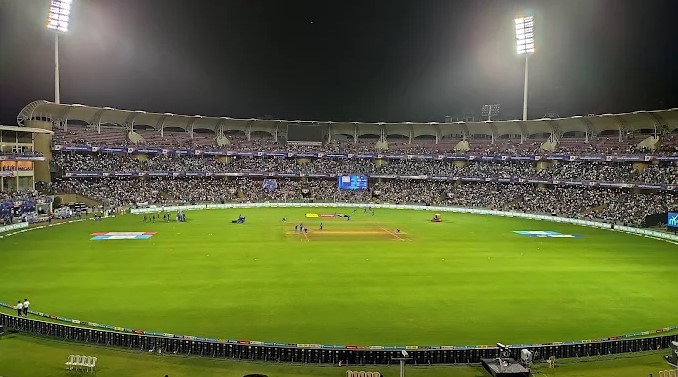DY Patil Stadium: Cricket stadiums around the world vary in design, size, and features — all of which can influence how the game is played. One of the most critical features is the boundary length, which refers to the distance from the pitch’s center to the boundary rope. Among the notable stadiums in India, the DY Patil Stadium, located in Navi Mumbai, stands out for its modern infrastructure and unique layout. This article explores the boundary length of DY Patil Stadium, its implications, and how it compares with other major cricket stadiums.
Table of Contents
DY Patil Stadium: An Overview
Before delving into the boundary specifics, here’s a snapshot of the stadium:
| Feature | Detail |
|---|---|
| Name | DY Patil Sports Stadium |
| Location | Nerul, Navi Mumbai, Maharashtra |
| Established | 2008 |
| Seating Capacity | 55,000 |
| Primary Uses | Cricket, Football, Concerts |
| Ownership | DY Patil Sports Academy |
Designed by Hafeez Contractor, the stadium is part of the DY Patil University Campus. It has hosted Indian Premier League (IPL) matches, concerts, and even the FIFA U-17 World Cup.
Boundary Dimensions of DY Patil Stadium
Unlike fixed architectural features, boundary lengths in cricket can be slightly variable due to repositioning of the pitch or turf maintenance. However, average measurements give a good idea of how “short” or “long” a stadium is.
Standard Boundary Length
According to ICC regulations:
- Minimum boundary distance from the center of the pitch: 59.43 meters (65 yards)
- Maximum allowed: 82.29 meters (90 yards)
DY Patil Stadium Boundary Measurements
| Direction | Average Boundary Length (Meters) | Approx. Yards |
|---|---|---|
| Straight | 74 meters | 81 yards |
| Square | 68 meters | 74 yards |
| Long-on/Long-off | 70 meters | 76 yards |
| Third Man/Fine Leg | 66 meters | 72 yards |
These measurements are average values and can vary slightly depending on the match setup.
Impact on Gameplay
Boundary lengths significantly affect how a cricket match unfolds. Here’s how the boundary dimensions at DY Patil Stadium impact the game:
1. High-Scoring Venue
With relatively shorter square boundaries and average straight boundaries, DY Patil favors aggressive stroke play. In IPL matches, the stadium has seen high run chases and totals crossing 200+ frequently.
2. Spinners vs Pacers
- Spinners may struggle due to the ease with which batters can target the shorter boundaries.
- Medium pacers and death bowlers often rely on variations rather than pace to succeed.
3. Six-Hitting Frequency
Due to favorable dimensions, batters with power-hitting abilities often prefer DY Patil as a venue. IPL games here often see 15+ sixes in a single innings.
Comparisons with Other Indian Stadiums
| Stadium | Location | Straight Boundary (m) | Square Boundary (m) | Notes |
|---|---|---|---|---|
| DY Patil Stadium | Navi Mumbai | 74 | 68 | Compact, high-scoring ground |
| Wankhede Stadium | Mumbai | 72 | 66 | Similar to DY Patil |
| Eden Gardens | Kolkata | 76 | 69 | Slightly longer boundaries |
| Narendra Modi Stadium | Ahmedabad | 80 | 74 | One of the largest in India |
| M. Chinnaswamy Stadium | Bengaluru | 70 | 63 | Very short boundaries, batsman’s paradise |
As seen in the table, DY Patil Stadium fits within the medium-sized category, striking a balance between hitter-friendly and bowler-supportive layouts.
Architectural Design and Influence
One reason DY Patil’s boundary dimensions are so symmetrical and standardized is its modern design. Built after 2005, it was engineered with multi-sport flexibility in mind. Here are some unique architectural features that impact gameplay:
- Elevated stands create a slight wind tunnel effect, assisting bowlers in certain conditions.
- Evenly shaped outfield makes ball retrieval consistent across directions.
- Consistent turf quality, maintained by international groundskeeping standards.
Evolution of Boundaries in T20 Cricket
Modern cricket has seen a shrinking of boundary sizes to encourage exciting, high-scoring games.
How DY Patil Compares Globally
| Stadium | Country | Average Boundary Length |
|---|---|---|
| DY Patil Stadium | India | 68-74 meters |
| Eden Park (Auckland) | New Zealand | 55-65 meters |
| MCG (Melbourne) | Australia | 80-85 meters |
| Sharjah Cricket Stadium | UAE | 60-65 meters |
| Lord’s (London) | England | 70-78 meters |
Spectator Experience and Boundary Perception
From a fan’s perspective, shorter boundaries mean more frequent sixes and fours — an adrenaline rush that defines modern T20 cricket. DY Patil’s proximity to the playing area offers fans an immersive experience:
- Fans are closer to the action, making sixes feel more thrilling.
- Even distribution of stands offers good visibility of boundary plays.
Summary: Key Points
| Attribute | Value |
|---|---|
| Average Straight Boundary | 74 meters |
| Average Square Boundary | 68 meters |
| Stadium Type | Multi-purpose |
| Ideal for | High-scoring T20s, aggressive batting |
| Comparison with Global Grounds | Medium-sized |
The boundary length of DY Patil Stadium places it comfortably within the category of modern, fan-friendly cricket venues. Neither too compact to make bowling meaningless, nor too expansive to curb excitement, its design achieves a balance that suits the nature of contemporary cricket. As the game continues to evolve, such stadiums will likely remain central to the spectacle of formats like the IPL, where boundary length plays a quiet yet powerful role in shaping strategy, entertainment, and the final score.


